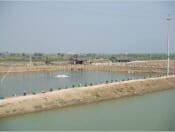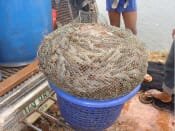Results from trials carried out under the supervision of UK Government Agency CEFAS (the Centre for Environment, Fisheries & Aquaculture Science), in partnership with Kiotech International and in collaboration with aquaculture and fish institutes in China and Thailand, showed the feeding system to be very effective.
The findings will be outlined at Victam International in May by Dr Andrew Moore, Head of Salmon and Freshwater Fisheries at CEFAS. They could offer significant commercial benefits to participating farmers and equally important, may bring environmental advantages as well.These results demonstrate the effectiveness of pheromone-based technology and provide the impetus to start work on commercialising current products says Dr Andrew Moore. The success of the trials should also encourage the development of products tailored to other commercially important species.
Performance benefits

The trials on Tilapia (Oreochromis niloticus) were conducted in Zhouhai, China over a six month period. The application of the Tilapia Aquatice pheromone product, showed a 17% increase in the average weight of the Tilapia compared to the control pond. Aquatice also increased the growth rate of the fish allowing the farmer to start harvesting three weeks earlier than the control pond. In addition the fish in the Aquatice treated pond appeared healthier, with better water quality - the secondary crop of White Shrimp was of significantly higher volume with less incidence of disease. The commercial advantage was that, the farmer received a 50% higher income from the Aquatice treated pond than the control.
In White Shrimp (Litopenaeus vannamei), the trial was conducted in Tradt, south east Thailand over a three month period. The White Shrimp Aquatice product was applied coated to the commercial shrimp feed. The shrimps fed the Aquatice coated feed produced Shrimp that were 30% larger on average than the control Shrimp. Growth rates were also significantly faster. In addition, less feed was required in the Aquatice pond, probably due to increased feeding activity by the Shrimp. This was reflected in an improved Food Conversion Rate (FCR) at harvest compared with shrimp raised in the control pond.
Environmental plus

On the environmental side, the use of pheromone based attractants can also reduce the amount of feed waste and so pollution. In the longer term, it is expected that pheromone-based feeding technology will be used to permit the use of more sustainable forms of proteins within aquatic feeds, that are not based on fish oils or proteins. This approach will further conserve and protect wild fish populations and provide a sustainable base for the large-scale expansion of the aquaculture sector. Dr Andy Moore will be speaking at Aquafeed Horizons at Victam International on 9 May. The event is being held in Utrecht http://www.victam.com/index. Fish pond picture: Commercial trails feeding Tilapia with feed with a pheromone attractant show positive performance benefits Shrimp pic: Faster growth, increased feeding activity and larger shrimps. Pheromone feeding technology has advantages for producers and the environment.
April 2007


